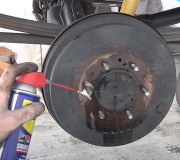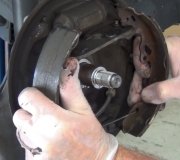Thread a lug nut onto the stud, then pound on that to push each stud out. Pound on the flat side of the nut, not the tapered friction side. The hub will fall out of the drum.
It is real easy and common to run into problems installing the new drum. You have to be sure the studs and holes are perfectly centered, then stack a few washers or a nut over two of the studs, then add the lug nuts, flat side against those washers. Tighten the two lug nuts to draw the studs in evenly, then do the other two. Be sure those washers you are using for spacers have holes plenty large so they do not get stuck on the serrations at the base of the studs.
If the studs are not perfectly centered in the holes, one side of the hole will bend up from the head of the stud. That can cause the wheel to not sit flat on the drum, and it can even cause the brake drum to wobble and cause a pulsing brake pedal.
Use a click-type torque wrench to tighten the nuts evenly to 100 foot pounds. Over-tightening them can peel the threads and make them impossible to remove next time. They will just spin and not unthread. Once tightened, tap on the heads of the studs to help them seat fully. Tighten them again, then tap them again, and repeat as long as they keep turning, with no more than 100 foot pounds of torque.
When you install the wheels, use the torque wrench to tighten the nuts to 95 foot pounds with steel wheels, and 85 foot pounds if you have cast wheels. Drive the car a few miles, then retighten the lug nuts. Side loading on the wheels will continue to draw the studs in. You may want to check the tightness two or three times.
Saturday, August 26th, 2017 AT 8:55 PM



